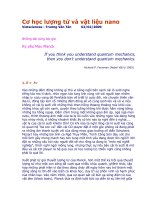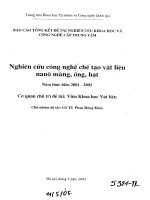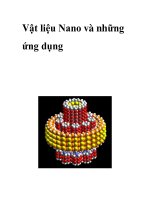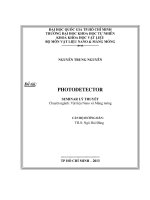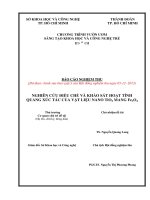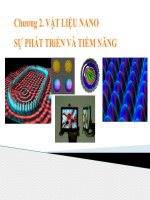Slide vật liệu nano và màng mỉng subtainability
Bạn đang xem bản rút gọn của tài liệu. Xem và tải ngay bản đầy đủ của tài liệu tại đây (739.33 KB, 34 trang )
co
ng
.c
om
Thermoelectrics for Energy
cu
u
du
o
ng
th
an
Sustainability
/>CuuDuongThanCong.com
/>
Thermoelectrics for Energy
.c
om
Heat in Energy Use
cu
u
du
o
ng
th
an
co
ng
Heat plays a major role in global energy consumption. Heat itself may the
be final use of energy (e.g. residental heating). Heat is also a waste
product in the transformation of energy, for example in electric power
generation or transportation.
CuuDuongThanCong.com
/>
.c
om
ng
co
an
th
ng
du
o
u
cu
CuuDuongThanCong.com
/>
du
o
ng
th
an
co
ng
.c
om
More than 60% of the energy produced in the U.S. is never utilized, most
of it in the form of waste heat. Thermoelectric materials allow the direct
conversion between thermal and electrical energy, and can therefore
recover some of this lost energy. From the above chart, a major
contributor to waste heat is in the transportation sector where only 20%
of the fuel's energy ends up as useful energy.
cu
u
Thermal energy (heat) is a common link between many forms of energy.
This means that improving the net heat to electricity efficiency, or
bypassing the thermal energy step altogether (as in fuel cells), will
improve energy utilization.
CuuDuongThanCong.com
/>
.c
om
ng
co
an
th
ng
du
o
u
cu
CuuDuongThanCong.com
/>
.c
om
co
ng
Improving thermal efficiency should be a major activity to reduce carbon
dioxide emissions because its implementation will, in many instances,
actually save money (figure below).
cu
u
du
o
ng
th
an
Insulation improvements and efficient water heating will reduce carbon
emissions and, over the long term, save more in energy costs than the
cost of the improvements even without a carbon tax.
CuuDuongThanCong.com
/>
.c
om
ng
co
an
th
ng
du
o
u
cu
CuuDuongThanCong.com
/>
.c
om
Waste Heat Recovery
an
co
ng
Automobiles are an example of high energy usage with low efficiency.
Roughly 75% of the energy produced during combustion is lost in the
exhaust or engine coolant in the form of heat.
cu
u
du
o
ng
th
By utilizing a portion of the lost thermal energy to charge the battery
instead of using an alternator (adds drag on the engine) the overall fuel
economy can be increased by about 10%.
CuuDuongThanCong.com
/>
.c
om
ng
co
an
th
ng
du
o
u
cu
CuuDuongThanCong.com
/>
cu
u
du
o
ng
th
an
co
ng
.c
om
Depending on the engine load the exhaust temperatures after the
catalytic converter reach about 300-500 degrees Centigrade.
Thermoelectric generators are ideal for such applications as they are
small, with no moving parts, and relatively efficient at these
temperatures.
CuuDuongThanCong.com
/>
.c
om
Cogeneration of Heat and Electricity
ng
th
an
co
ng
Because most electricity is produced by a heat engine, which is limited by
Carnot efficiency, much of the energy is lost in the heat rejected. A typical
steam power plant is only 40% efficient. The remaining heat is wasted,
unless this rejected heat can be used for heating. The use of this heat then
can add to the energy utility.
cu
u
du
o
Conversely, any time a fuel is burned to make low temperature heat (such
as in a home) the ability to produce useful work or electricty from that
heat is wasted. A small cogeneration plant in the home would produce
electricty whenever the heat is needed. The added fuel consumed to
produce the electricity has essentially the same energy content as the
electricity produced. Thus in terms of energy untilization the efficiency of
electricity generation approaches 90% compared to the 40% in a typical
power plant.
CuuDuongThanCong.com
/>
.c
om
ng
co
an
th
ng
du
o
u
cu
Thermoeletric systems are ideal for small (e.g. single family home) cogeneration because
they could be small and silent. Even with their lower thermal to electric efficiency
compared to dynamic heat engines, the electricity would be produced with high efficiency
(electric power/extra fuel consumed) because the heat rejected will not be wasted.
CuuDuongThanCong.com
/>
.c
om
ng
co
cu
u
du
o
ng
th
an
The Science of Thermoelectric Materials
CuuDuongThanCong.com
/>
.c
om
ng
co
an
th
ng
du
o
u
cu
CuuDuongThanCong.com
/>
.c
om
The Seebeck Effect
co
ng
In a thermoelectric material there are free electrons or holes which carry
both charge and heat.
th
an
The electrons and holes in a thermoelectric semiconductor behave like a
gas of charged particles.
cu
u
du
o
ng
If a normal (uncharged) gas is placed in a box within a temperature
gradient, where one side is cold and the other is hot, the gas molecules
at the hot end will move faster than those at the cold end.
The faster hot molecules will diffuse further than the cold molecules and
so there will be a net build up of molecules (higher density) at the cold
end. The density gradient will drive the molecules to diffuse back to the
hot end.
CuuDuongThanCong.com
/>
.c
om
The Seebeck Effect
co
ng
In the steady state, the effect of the density gradient will exactly
counteract the effect of the temperature gradient so there is no net flow
of molecules.
cu
u
du
o
ng
th
an
If the molecules are charged, the buildup of charge at the cold end will
also produce a repulsive electrostatic force (and therefore electric
potential) to push the charges back to the hot end. The electric potential
(Voltage) produced by a temperature difference is known as the Seebeck
effect and the proportionality constant is called the Seebeck coefficient.
If the free charges are positive (the material is p-type), positive charge
will build up on the cold which will have a positive potential. Similarly,
negative free charges (n-type material) will produce a negative potential
at the cold end.
CuuDuongThanCong.com
/>
.c
om
Thermopower Peak and Band Gap
ng
th
an
co
ng
In a semiconductor at high enough temperature electrons will have high
enough energy to excite across the band gap. When that happens there
will be both n-type carriers in the conduction band and p-type carriers in
the valence band such that the resultant thermopower (absolute value of
Seebeck coefficient) will be compensated (reduced) because the two
contributions subtract.
cu
u
du
o
In a heavily doped semiconductor, where the dopants produce many
majority carriers (could be either n-type or p-type) the thermopower will
be reduced at high temperature due to the excitation of minority carriers
of opposite sign. Although there are fewer minority carriers than
majority carriers, they have a larger thermopower. This leads to a peak in
the thermopower as a function of temperature.
CuuDuongThanCong.com
/>
.c
om
ng
co
an
th
ng
du
o
u
cu
The Figure above shows how the Seebeck coefficient changes when the doping changes from
lightly doped (blue) to heavily doped (red).
CuuDuongThanCong.com
/>
.c
om
cu
u
du
o
ng
th
an
co
ng
The Temperature at which the thermopower peaks, Tmax, and the
thermopower (absolute value of Seebeck coefficient) of the peak, |S|max,
can be used to estimate the semiconducting band gap, Eg
CuuDuongThanCong.com
/>
.c
om
Thermoelectric Power Generation
du
o
ng
th
an
co
ng
If the hot ends of the n-type and p-type material are electrically
connected, and a load connected across the cold ends, the voltage
produced by the Seebeck effect will cause current to flow through the
load, generating electrical power. The electrical power produced is the
product of the voltage and electrical current across the load. The
temperature difference provides the voltage but it is the heat flow which
enables the current.
cu
u
A thermoelectric generator behaves much like an ideal voltage soure with
an internal resistance due largely to the resistance of the thermoelectric
materials themselves. The voltage at the load is reduced from the open
circuit voltage by the Ohm's law (V = IR) voltage drop due to this internal
resistance. Maximum efficiency is reached when the load and internal
resistances are nearly equal because this is close to the maximum power
achieved from load matching.
CuuDuongThanCong.com
/>
.c
om
ng
co
an
th
ng
du
o
u
cu
CuuDuongThanCong.com
/>
cu
u
du
o
ng
th
an
co
ng
.c
om
The resistance of the thermoelectric elements depend on the electrical
resistivity as well as the length and cross sectional area.
CuuDuongThanCong.com
/>
du
o
ng
th
an
co
ng
.c
om
Just as the power in a resistor is V2/R the power produced in a
thermoelectric generator depends on the square of the voltage (Seebeck
coefficient and temperature difference) divided by the resistivity. Notice
also that the power per area can be arbitrarily adjusted with l (length)
cu
u
The efficiency of a generator depends not just on the power produced but
also how much heat is provided at the hot end. The heat input is needed
for the thermoelectric process (Peltier effect) as well as normal thermal
conduction (Fourier's law) and is offset by the Joule heating in the device.
The Fourier's law thermal conduction of the thermoelectric materials add
a thermal path from hot to cold that consumes some heat and reduces
the efficiency.
CuuDuongThanCong.com
/>
cu
u
du
o
ng
th
an
co
ng
.c
om
It can be shown that the maximum efficiency of a thermoelectric material depends on
two terms. The first is the Carnot efficiency, for all heat engines can not exceed Carnot
efficiency. The second is a term that depends on the thermoelectric properties, Seebeck
coefficient, electrical resistivity and thermal conductivity. These material properties all
appear together and thus form a new material property which we call zT, the
Thermoelectric Figure of Merit. For small temperature difference this efficiency is given
by:
CuuDuongThanCong.com
/>
.c
om
Peltier Cooling
cu
u
du
o
ng
th
an
co
ng
If instead of having the heat flow drive the charge flow, we use an
external electric potential to drive the heat carrying charges, then we
can force heat to flow from one end to the other. The coefficient of
performance and the maximum temperature drop that can be achieved
is again related to the efficiency of the thermoelectric materials through
the thermoelectric figure of merit zT.
CuuDuongThanCong.com
/>

